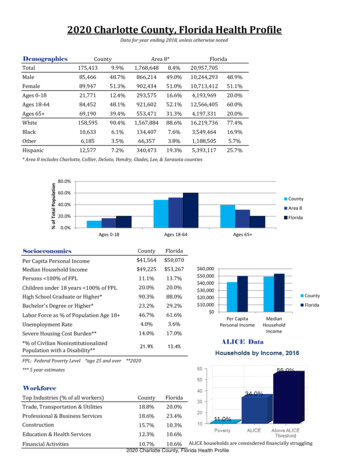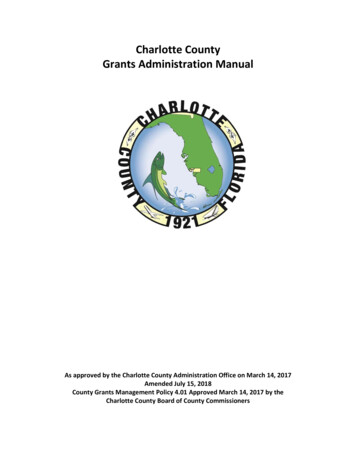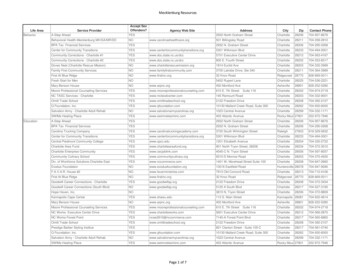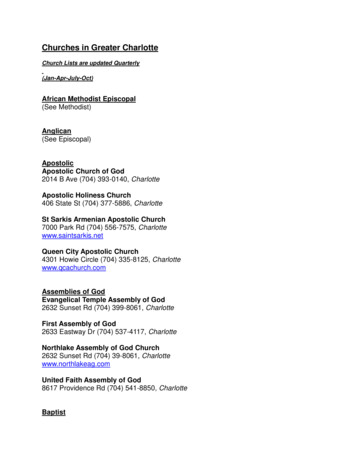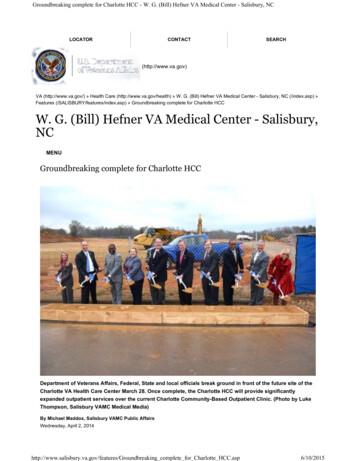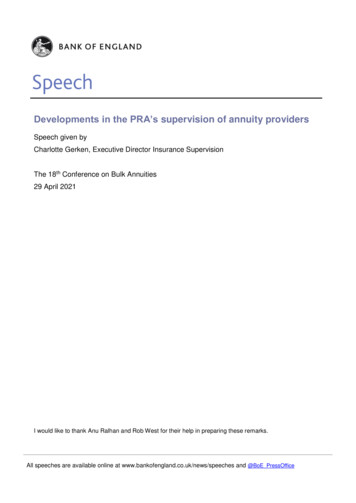
Transcription
Developments in the PRA’s supervision of annuity providersSpeech given byCharlotte Gerken, Executive Director Insurance SupervisionThe 18th Conference on Bulk Annuities29 April 2021I would like to thank Anu Ralhan and Rob West for their help in preparing these remarks.1All speeches are available online at www.bankofengland.co.uk/news/speeches and @BoE PressOffice
Thank you to Westminster and City for inviting me to speak at your bulk purchase annuities conference.At the time the 2020 conference was scheduled to take place, we were all grappling with the early impacts ofthe COVID 19 pandemic on our work, our lives and loved ones. In the months since, life insurers’ staff haveworked hard and in challenging circumstances to serve their customers in very difficult times.As companies, life insurers have so far come through the pandemic well. That is not to say things have beenperfect, but we recognise the commitment of firms and their staff to ensuring business continuity –particularly important when considering in the case of annuity providers that an annuity may be a substantialportion of the retirement income of the recipient.In previous conferences (2018 and 2019), the former Executive Director for Insurance Supervision,David Rule, talked to you in his speeches ‘An Annuity is a very serious business’ Parts 1 and 2 1 about: The key risks facing annuity writers and the treatment of unrated, direct investments under theMatching Adjustment in 2018, with a focus on equity release mortgages; and How Solvency II works to address risks to annuity providers, serves protection of policyholders andallows insurers to invest for the long term in ways that support the UK economy in 2019There is continuity in that I will be looking at aspects of the Matching Adjustment (MA), but today I will befocussing on three areas of our supervisory risk analysis.1. I will take stock of market developments since 2019.2. I will talk about the implications of those developments for our supervision, in particular the MatchingAdjustment – putting it in context, setting out the rationale behind it, and discussing asset eligibilitymatters; and3. Finally, I will share some thoughts from our supervisory analysis on the size of the MA, how thecurrent fundamental spread (FS) approach has been implemented, and looking at the risk sensitivityof the FS.You will hear more on developments in regulation following HM Treasury’s Call for Evidence 2 in due course;but today I would like to explore what we have learnt through our supervision of annuity writers since theinception of Solvency II. What we have learned will, as you would expect, inform our considerations ofpotential Solvency II -longevity-risk-transfer 2All speeches are available online at www.bankofengland.co.uk/news/speeches and @BoE PressOffice2
1. Market developments since 2019The annuity market largely bifurcates into bulk purchase annuities and the purchase of annuities frompersonal and occupational pensions. Since David spoke to you in 2019 the growth in the bulk annuitymarket has continued, and is expected to continue [Chart 1 in the Appendix].From our perspective, the additional capital that annuity firms bring to back these pension obligationsprovides increased security for scheme members, and gives pension scheme sponsors the opportunity tobenefit from de-risking.For some insurers, annuities are part of a wider product set, diversifying with for example term assurance orgeneral insurance products. But for specialist annuity firms the increase in annuity sales leads toconcentration in both longevity and credit risk. Chart 2 shows the composition of the solvency capitalrequirement (SCR) across a range of specialist and mixed-line annuity firms:What this chart does not convey is that the longevity component would be notably larger were annuity writersretaining all of this risk. We are aware that the design of the risk margin has had a number of unwelcomeeffects such as adding excessive balance sheet volatility which has contributed to longevity risk beingsomething many annuity writers continue to look to cede. Our views on the risk margin have been set outpreviously, and we welcome its inclusion in HMT’s Call for Evidence on Solvency II reform.2. Implications for supervisionContextThe growth of annuity lines through bulk purchase transfers from defined benefit pension schemes, and thespecialisation in annuity lines, attracts significant supervisory focus. With much longevity risk currently beingreinsured, firms will not have failed to notice that our engagement on asset risk has increased markedly asinvestment returns on assets backing the annuities are the key driver of pricing in the bulk annuity market.MA portfolios have increased since the start of 2018 by 30%, to around 335bn 3 [Chart 3]. The range ofassets that firms hold in their MA portfolios suggests to us that Solvency II is not of itself a barrier to firmsinvesting in a wide range of asset classes. We see everything from covered bonds to infrastructure; andsocial housing to restructured Equity Release Mortgages (ERMs) backing annuity liabilities. And whilst themajority of exposures are what might be deemed traditional annuity assets, such as gilts and corporatebonds, less liquid exposures as a proportion of the MA portfolios are large and increasing [Chart 4].3QRT data at YE20, PRA Analysis3All speeches are available online at www.bankofengland.co.uk/news/speeches and @BoE PressOffice3
The risk management of less liquid assets is of particular concern to us. Insurers may be sole or significantinvestors in specialised lending and will require a commensurate level of expertise to assess, maintain andpotentially work-out such assets.Rationale for the MABefore discussing our supervisory analysis on MA portfolios, I will recap on the rationale for the MA.There are several schools of thought on whether illiquid liabilities should be discounted at a “risk-free” rate,or if it is appropriate in some cases to allow for some addition to the risk-free rate. The PRA accepts that acomponent of the credit spread represents an illiquidity premium, and that an allowance may be made forthis where firms: hold debt-like instruments to back annuities; are able to hold those assets to maturity; andthey closely match asset and liability cashflows. Solvency II has formalised the conditions for when thatilliquidity premium can be recognised, often referred to as “eligibility”.Under Solvency II this increase to the discount rate is called the MA. The MA reduces the value of liabilitiesin the base balance sheet, and hence increases own funds [Chart 5].The MA performed its expected function in 2020, allowing insurers to look through the sharp spike in creditspreads. And the MA also served broader financial stability as insurers did not behave in a procyclical way,as they did not need to sell assets as market prices fell [Chart 6].Asset eligibilityOn the eligibility side, Solvency II requires that the assets backing MA eligible liabilities should be ‘fixed’.This fixity in the assets results in a higher level of confidence that asset cash-flows will be available as theliabilities fall due; and hence that firms have largely mitigated credit spread exposures arising from beingeither forced sellers of assets or reinvestors of cash. It is for this reason that assets with prepayment risk aretypically not suitable for inclusion in matching portfolios, unless they include suitable protection from thefinancial consequences of prepayment.We are mindful that being closely matched today does not mean that all is well for the run off of the liabilities.Even for a fixed book of business, changes in demographic experience may result in divergence from initialexpectations. Therefore, it is important to us that firms regularly revisit their matching profile; indeed that iswhy we have set out tests in Supervisory Statement 7/18 “Solvency II: Matching adjustment”4 to assist withassessing ongoing matching. This is another reason why even a well matched firm may need to turn overpart of its portfolio over time, suggesting prudence is necessary when deciding how much MA benefit toclaim based on its current matching ent/2018/ss718.pdf4All speeches are available online at www.bankofengland.co.uk/news/speeches and @BoE PressOffice4
In our view the MA does not stop firms investing in assets such as construction phase assets structured asdebt, or in pools of assets that might not be MA eligible themselves. As I said earlier, MA portfolios alreadyinclude many types of debt instrument, and where assets are not MA eligible firms may consider – ifappropriate – holding them outside the MA portfolio to back other liabilities. And the PRA has taken, as faras possible, a pragmatic approach to fixity – for example for floating rate bonds and for assets withinadequate modified Spens clauses.Over 2020, we saw very few applications for asset classes not already held in peer MA portfolios, insteadseeing firms applying to invest in less liquid asset classes such as ground rents and ERMs. While the assetclasses may not be new to us, firms can expect to be challenged when investing in asset classes that arenew to them. We have published supervisory expectations in Supervisory Statement 1/20 “Solvency II:Prudent Person Principle”5 and Supervisory Statement 8/18: “Solvency II: Internal models – modelling of thematching adjustment”6. These cover risk management aspects including the consistency of investments withthe prudent person principle, the ability to manage the assets – including in stress or in default – and theability to model the solvency capital requirement appropriately.Next I would like to touch on the future direction for new asset classes in MA portfolios. As Sam Woods, theDeputy Governor for Prudential Regulation, and PRA’s Chief Executive said in his March speech7 at the ABI,we are wary of calls to encourage specific forms of investment with prudential regulatory incentives. We dowant to see firms invest in ways that support the wider economy, including to manage the risks arising fromclimate change. However when assessing capital requirements, and here I am thinking of ‘green’ assets and‘productive finance’, we must as a prudential regulator consider the risks in individual assets. A departurefrom such an approach reduces the resilience of firms and potentially the wider financial system.However, as Sam also said we are open to removing unnecessary barriers. A significant constraint currentlyis the binary nature of MA approvals, and in the course of supervisory engagement firms have raised the riskof the loss of the MA where breaches have not been rectified within two months. As part of considering theresponses to HMTs Call for Evidence on Solvency II reform, we will review the MA approvals process. And,whether changes there need to be balanced by stronger post-approval supervision to ensure the MAframework continues to work as intended.3. Supervisory analysis on sizing the MAOnce assets are in the MA portfolio, Solvency II sets out the mechanism for deriving the fundamental spread(FS), which reflects an allowance for risks retained by insurers. Deducting the fundamental spread from thecredit spread, gives the quantum of the MA [Chart nar675All speeches are available online at www.bankofengland.co.uk/news/speeches and @BoE PressOffice5
The current calibration of the FS has three components for investment grade assets: the probability ofdefault, the cost of downgrades, and a floor based on long term average spreads (the LTAS floor). Forsub-investment grade assets a fourth component limits the MA on such assets to that of an investment gradecorporate bond.The components of the FS are based on historic averages to varying degrees, notably the LTAS floor whichis 35% of the average spread over the previous 30 years. What often surprises is the extent to which theLTAS floor actually bites, for example in Chart 8 we show the components of the FS for non-financial BBBcorporate bonds, which highlights that the LTAS floor is often biting.The LTAS floor is, as the name says, a long term average. Accordingly it is relatively unresponsive tochanges in market spreads, and this is a key reason for the FS being slow to respond to market signals.Implementation issuesMoving from FS components to firms’ implementation: to know what FS to apply, firms are required todetermine two parameters; the credit quality step (CQS) and the fundamental spread sector.Firstly, the CQS.For many assets in MA Portfolios the CQS can be mapped by looking at the rating assigned by an ExternalCredit Assessment Institution (ECAI). However, as I mentioned earlier, we see increasing volumes of lessliquid and more complex assets for which firms have themselves to assign a CQS.Given firms’ judgements play an important role in determining the CQS we need to be confident that theirinternal rating processes are robust. We have set expectations for firms in Supervisory Statement 3/17:“Solvency II: Illiquid assets”8, that where ratings are a significant driver of technical provisions and capitalrequirements, we expect those ratings assigned by firms to be broadly consistent with public ratings thatcould be obtained from ECAIs. Consistency with ECAI public rating methodologies, including any allowancefor rating caps, are key points to distinguish from opinions ECAI only provide privately, based on otherassumptions.Rating consistency remains a key area of PRA engagement with firms, and to demonstrate consistency firmsneed to show that they understand what ECAIs do, and then to internalise this in their own processes.Secondly, the fundamental spread sector.As well as credit rating, the sector that an asset comes from is a key driver of the FS. Chart 9 compares atyear-end 2020 the FS for A-rated assets depending on whether the financial or non-financial FS is 2020/ss317-update-april-2020.pdf6All speeches are available online at www.bankofengland.co.uk/news/speeches and @BoE PressOffice6
A key challenge in Solvency II is that the FS has been calibrated for corporate bonds, but firms now holdever increasing exposures to less liquid asset classes, with significant basis risks between asset exposuresand the FS calibration data. We consider that there is potential merit in differentiating the FS by asset class,however, this needs to be balanced against the extent to which different asset classes are sufficientlyhomogenous, as well as the availability and credibility of data available to derive such calibrations.A more granular FS could therefore give rise to additional risks. Related to this, firms make their owndelineation between financial and non-financial assets, and it is important that their assumptions are prudent.Risk Sensitivity of the FSThe current construct of the fundamental spread has some advantages: it has been largely predictable understress, and it promotes counter-cyclicality. However, it is reasonable to ask whether the FS has gone too farin this direction. The impact of the long-term average spread floor makes the FS a predominantly backwardslooking measure, insensitive to current market signals.For example, in Chart 10 are the credit spreads for A-rated financial corporate bonds, set against theyear- end 2020 FS9.Under stress, firms will only see the FS increase under a ratings downgrade, thus completely setting asideany information contained in market spreads. Such ratings downgrades may not occur immediately, leavinga window where policyholders may be less well protected. Further, where ratings downgrade by a notch butremain within the same CQS, again the FS is unchanged.Another way of looking at the question is to consider how much of the credit spread the FS strips out inpercentage terms [Chart 11].So, at year-end 2020 perhaps 70% of the credit spread on such assets is removed for retained risks, with amuch lower figure if spreads reached the levels seen in the Global Financial Crisis. The insensitivity tomarket signals is a feature of the current FS construct, and is why for internal model firms we set anexpectation in Supervisory Statement 8/18: “Solvency II: Internal models – modelling of the matchingadjustment”10, that when determining the FS in stress firms should not simply mechanistically recalculate theFS, but should determine a stressed FS that better reflects the risks retained.To be more forward looking, one alternative could be for an approach where the risk allowance reflectscompensation for: expected losses; uncertainty around expected losses; and any further risks retained byinvestors. Such an approach might place less weight on credit ratings, which particularly in the case ofinternal ratings present challenges around availability of data, and expertise in the business and risk9Illustrative bonds of 10-15 year term, duration c. 10 year at 18/ss818.pdf107All speeches are available online at www.bankofengland.co.uk/news/speeches and @BoE PressOffice7
teams. A framework that takes some signals from market prices could be more forward looking, forexample, recognising the market pricing of climate risks, rather than a backwards view of the risks of failure.However, any alternative framework may bring in new risks, potentially in being over risk-sensitive; or forexample if provisions are linked to credit spreads, there may be incentives to value assets nearer the top endof the plausible range, understating the credit spread. While this is likely a smaller risk for traded corporatebonds, the shift to less liquid assets brings in greater scope for valuation uncertainty, which may also need tobe factored into the FS.ConclusionI have focussed today on risks inherent in the MA, in particular on risks from less liquid assets stemmingfrom uncertainty about the credit rating, uncertainty around valuations, and uncertainty about the amount ofMA benefit that should be taken as a credit to insurers’ balance sheets. These are all risks that insurers’Boards and senior management need to be across and to understand the vulnerabilities in assumptions thathave to be made.The MA is a significant benefit for firms, in bringing forward unrealised profits that are then available to bedeployed to grow businesses, or to reward shareholders. However, an addition to the risk-free rate isappropriate for annuities where they are well matched, and the MA is a valuable source of resilience forannuity writers. We will want to continue to have a very high level of confidence that there are no materialrisks to those returns being earned.Close supervision of the MA contributes to securing an adequate degree of protection for policyholders andwe will continue to develop our analysis both to improve our supervision and to inform policy development.The Call for Evidence has drawn a wide range of views on the nature of the MA and we are committed toworking with industry and HMT to deliver meaningful and progressive reform to Solvency II, in line withHMT’s objectives for the review.Annuity writers may rightly feel that they receive significant supervisory challenge from the PRA. This will notchange, given the nature and importance of the annuity product, the significant judgements and assumptionsthat underpin the MA benefit available to firms, and the impact of annuity providers on our policyholderprotection objective.As you have heard before, from Jane Austen and David Rule, annuities are a very serious business.8All speeches are available online at www.bankofengland.co.uk/news/speeches and @BoE PressOffice8
AppendixChart 1: Buy-in, buy-out and longevity swap volumes. Source: LCPChart 2: Breakdown of the major UK annuity writers’ SCR (YE19). Source: QRTs, PRA analysis, YE199All speeches are available online at www.bankofengland.co.uk/news/speeches and @BoE PressOffice9
Chart 3: MA Portfolios. Source: QRTs, PRA analysisChart 4: Illiquid proportion of MA portfolio assets. Source: QRTs, PRA analysis10All speeches are available online at www.bankofengland.co.uk/news/speeches and @BoE PressOffice10
Chart 5: The impact of MA on the base balance sheet. Source: PRA analysis, Solvency II RegulationsChart 6: Credit Spread on Investment Grade Corporate Bonds. Source: Bloomberg data, PRAanalysis11All speeches are available online at www.bankofengland.co.uk/news/speeches and @BoE PressOffice11
Chart 7: Decomposition of Bond Spread. Source: PRA analysis, Solvency II RegulationsChart 8: FS Components: Non-Financial CQS 3 (BBB-rated). Source: PRA analysis, YE2012All speeches are available online at www.bankofengland.co.uk/news/speeches and @BoE PressOffice12
Chart 9: FS – Credit Quality Step 2 (A-rated). Source: PRA analysis, YE20Chart 10: Illustrative A-rated 10 year financial bond. Source: Bloomberg data, PRA analysis13All speeches are available online at www.bankofengland.co.uk/news/speeches and @BoE PressOffice13
Chart 11: 2020YE FS as % spread - Illustrative A-rated 10 year financial bond. Source: Bloombergdata, PRA analysis using YE20 FS14All speeches are available online at www.bankofengland.co.uk/news/speeches and @BoE PressOffice14
the COVID 19 pandemic on our work, our lives and loved ones. In the months since, life insurers' staff have worked hard and in challenging circumstances to serve their customers in very difficult times. As companies, life insurers have so far come through the pandemic well. That is not to say things have been




